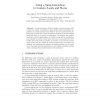Free Online Productivity Tools
i2Speak
i2Symbol
i2OCR
iTex2Img
iWeb2Print
iWeb2Shot
i2Type
iPdf2Split
iPdf2Merge
i2Bopomofo
i2Arabic
i2Style
i2Image
i2PDF
iLatex2Rtf
Sci2ools
EUROPAR
2001
Springer
2001
Springer
Using a Swap Instruction to Coalesce Loads and Stores
A swap instruction, which exchanges a value in memory with a value of a register, is available on many architectures. The primary application of a swap instruction has been for process synchronization. In this paper we show that a swap instruction can often be used to coalesce loads and stores in a variety of applications. We describe the analysis necessary to detect opportunities to exploit a swap and the transformation required to coalesce a load and a store into a swap instruction. The results show that both the number of accesses to the memory system (data cache) and the number of executed instructions are reduced. In addition, the transformation reduces the register pressure by one register at the point the swap instruction is used, which sometimes enables other code-improving transformations to be performed.
| Added | 28 Jul 2010 |
| Updated | 28 Jul 2010 |
| Type | Conference |
| Year | 2001 |
| Where | EUROPAR |
| Authors | Apan Qasem, David B. Whalley, Xin Yuan, Robert van Engelen |
Comments (0)

